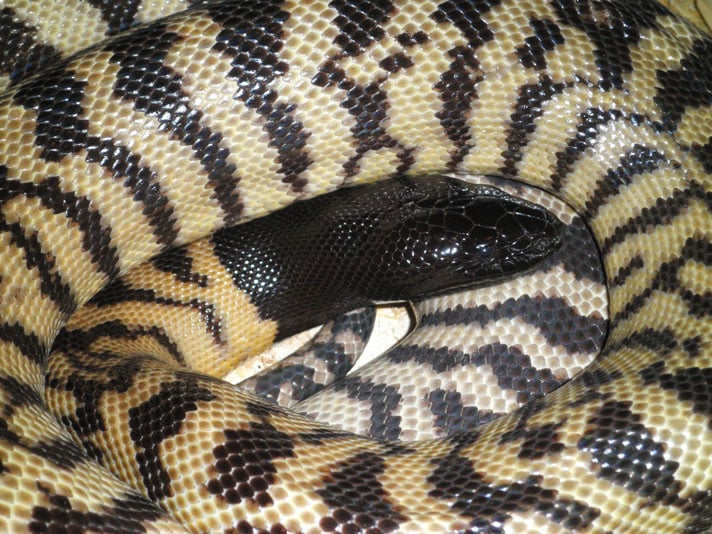The black-headed python is costly, but its fans consider this majestic snake more than worth the investment.
Aspidites melanocephalus, commonly known as the black-headed python, is broadly distributed throughout the northern third of Australia, extending from east to west across the continent, including a majority of the Northern Territory, the northern latitudes of Queensland and the northern third of Western Australia.
One look at this gorgeous snake and you’ll know how it came by its common name; it appears to have been dipped head-first into black ink. The black head and jaws are long, with a head not much wider than the neck—a feature, along with the python’s strengthened rostral area, that makes this species well suited for burrowing. The eyes are black, and the scalation is smooth and glossy.
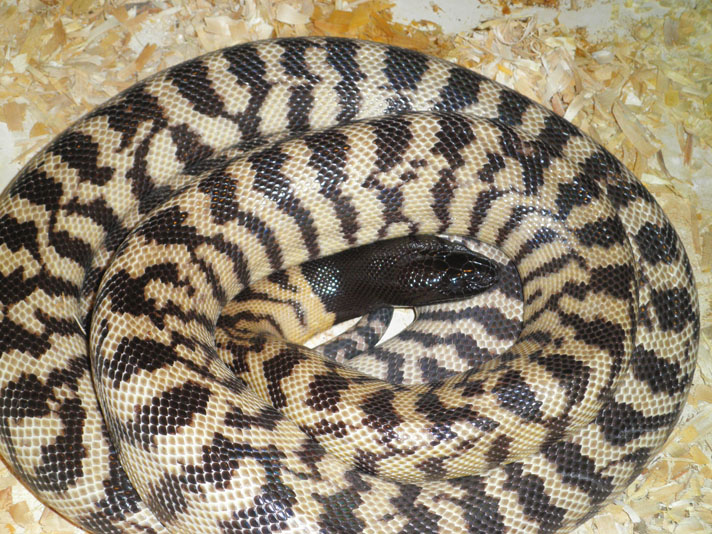
Jessica Johnson
One look at the black-headed python and you’ll know how it came by its common name; it appears to have been dipped head-first into black ink.
While a cream base color with brown to reddish stripes on the body is typical, the coloration of black-headed pythons can vary extensively depending on a snake’s age and geographic location. For example, Western Australian specimens are much lighter in color, with reddish overtones, than those found in the Northern Territory and Queensland, which have darker, more intense stripes. Older specimens tend to be paler with less-distinctive markings. There may also be small blotches between the stripes along the sides of some specimens, and the venter can range from white to pink, but can also exhibit dark spots similar to those along the dorsum.
Black-headed Python Availability in the Pet Trade
Due to captive-breeding efforts, black-headed pythons are more commonly available in the pet trade now than in years past. Aspidites melanocephalus is not an easy species to breed, and availability depends on the luck and attention to detail of the breeders. No matter how long someone has been breeding them, success is still often a matter of luck.
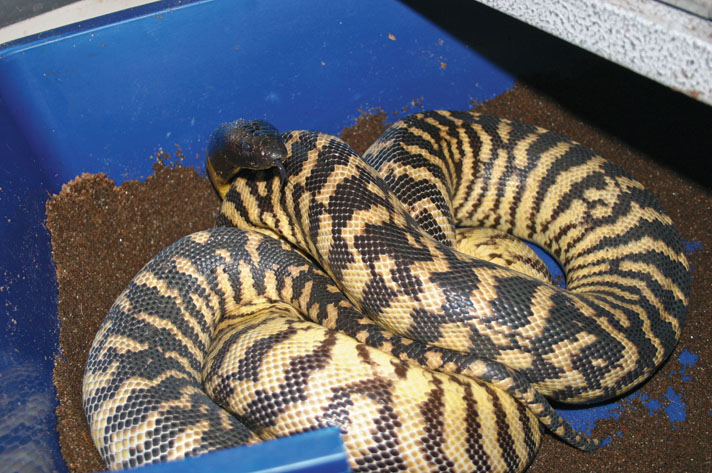
jessica johnson
The author prefers to never touch her black-headed pythons when she is feeding them.
Good-quality black-headed pythons are not cheap, and if you find some that are, be leery. Always try to buy from a reputable breeder who is willing to help you. I would rather spend time with potential buyers, explaining what is necessary in order for them to properly care for their new pet, than to have someone purchase a baby python from me and have something happen to it. I also recommend purchasing from breeders who can provide feeding records and photos of the parents of the snake you may be thinking about buying.
The Ideal Black-headed Python Enclosure
I highly recommend against housing black-headed pythons together unless you’re breeding them, as black-headed pythons do have cannibalistic tendencies. Adult black-headed pythons range from 5 to 10 feet in length; mine average 6 to 8 feet, with males generally smaller than the females by a foot. Because of their large adult size, black-headed pythons are best kept in large, escape-proof enclosures. I use Freedom Breeder racks and Vision cages. An enclosure measuring 72 inches long by 28 inches wide and 16 inches tall works well for a single black-headed python. For breeding pairs, I use enclosures that are a bit wider and taller (72 inches long by 36 inches wide and 18 inches tall).
For substrate, I use coconut bark (sometimes aspen chips), which I mist every day in order to maintain humidity. Black-headed pythons love to be misted. A water bowl is also provided for them to drink from.

jessica johnson
While a cream base color with brown to reddish stripes on the body is typical, coloration can vary extensively depending on age and geographic location. Western Australian specimens are much lighter in color, with reddish overtones, than those found in the Northern Territory and Queensland, which have darker, more intense stripes.
Large, moist hides are provided for both my male and female black-headed pythons (for whom the hides may double as nesting boxes). These provide security and also an opportunity for the snakes to burrow. I have used different types, including a plastic tote measuring 18 by 12 by 10 inches, with a round hole cut in its lid. I’ve also used kitty litter pans measuring 18½ by 15¼ by 5¾ inches. Inside each box I place a 70/30 mixture of moist Eco Earth or Bed-A-Beast and reptile sand.
Want To Learn More?
Comedian Kevin Hart Freaks as Ice Cube Handles a Black-headed Python
Black-headed Python Care Sheet
It is important to have at least one hide to provide security to the snake, and the moist substrate inside will aid in shedding. Place it in the hotspot at one end of the enclosure; place another at the cool end if there’s room to do so. Be sure to keep the substrate inside the hides moist, but not soaking wet. The goal is to provide security that will result in a happy and content snake. Because of the moist hides, my snakes do not soak in their water bowls.
Black-headed pythons need to be kept warm and may suffer respiratory infections if they are kept at temperatures that are too cool. I use heat tape to provide a temperature gradient, with the cool end of the enclosure kept at about 82 degrees Fahrenheit. A 95-degree hotspot is maintained at the warmer end of the enclosure using a basking light that is kept on for about eight hours a day. At night I turn off the basking light.
What to Feed Black-headed Pythons
In the wild, black-headed pythons prey on other reptiles, especially skinks, as well as different species of geckos, bearded dragons, legless lizards and small snakes, including some venomous species (black-headed pythons are impervious to the venom found in even the most toxic Australian snakes). Consumption of mammals and birds is reportedly rare in nature, but does occur.
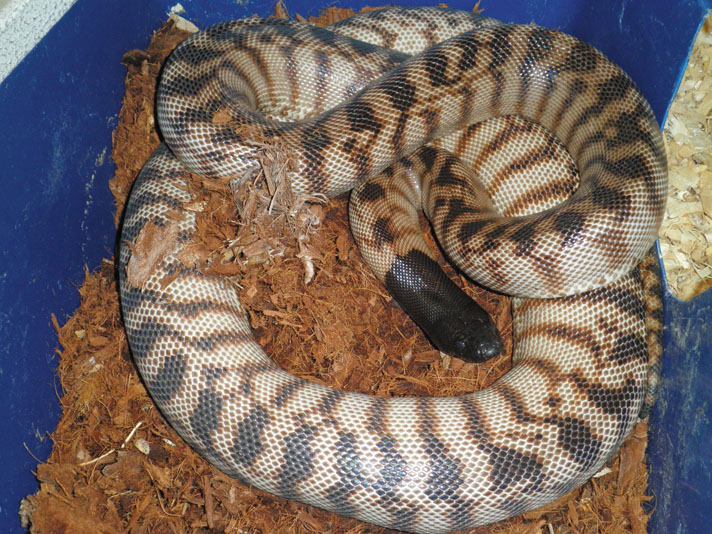
Jessica Johnson
Older specimens tend to be paler with less-distinctive markings. There may also be small blotches between the stripes along the sides of some specimens.
In my experience, captive black-headed pythons will typically accept rodents. I feed my adults small- to medium-sized rats every seven to 10 days. Males are fed a bit less than the females-four to five rats for males; five to six for females. Feeding several smaller food items is much better than one large meal, and I do not offer adult rats, due to the black-headed python’s narrow head and neck. I feed only frozen/thawed rats, too, because it is safer for the snakes and, based on personal experience, I think black-headed pythons that are fed live prey can exhibit more aggressive tendencies. Hatchlings are given frozen/thawed pinkie rats.
I place food items on a paper plate at the opposite end of the cage to where the snake is, and leave it alone to eat in peace. I always feed my snakes while they’re inside their cages, as I do not want any snake to expect food while it is being handled outside of its enclosure. When I feed them, I never touch them.
Breeding Black-headed Pythons
First, I recommend that when attempting to breed black-headed pythons, you start out with animals that are close to the same size. I have good luck if I wait until the snakes are about 4 years old (though I have bred males that were 2½). I’ve observed that as the snakes grow larger, so do their clutch sizes. This does not mean, however, that animals should be overfed to attain larger sizes faster. Overfeeding causes health problems and a shorter life span. I also do not breed my females every year. If they successfully breed three years in a row, I give them a year off to recover.

Jessica Johnson
Due to captive- breeding efforts, black-headed pythons are more commonly available in the pet trade now than in years past. Aspidites melanocephalus is not an easy species to breed, and availability depends on the luck and attention to detail of the breeders.
I stop feeding my black-headed pythons around the middle of October. (After speaking with other breeders working with this wonderful snake, and depending on where they are located, I found that they breed their black-headed pythons two to three months later than I breed mine because of climate differences. So your process for cycling the snakes for breeding may depend on where you live.) I keep them heated at the previously mentioned temperatures for three weeks after their last feeding in order to completely clean out their digestive tracts. It’s very important to do this; you definitely do not want to cool them while they still have food in their digestive tracts.
After three weeks I turn off the heat tape and cool them down to 68 to 70 degrees at night. During the day I raise the enclosure temperature to 78 to 80 degrees for 10 hours, and the hotspot remains at 95 degrees during the day, too.
After another three weeks I lower the nighttime temperature a few more degrees and introduce male black-headed pythons to the females. I have bred different males to the same female, as well as one male to one female, and have achieved the same results. Sometimes a male is not interested in a female. If this happens, he is removed and replaced with another male. Because male black-headed pythons will battle over females, placing a shed from another male in the cage with a pair will sometimes stimulate courtship activity from the male.
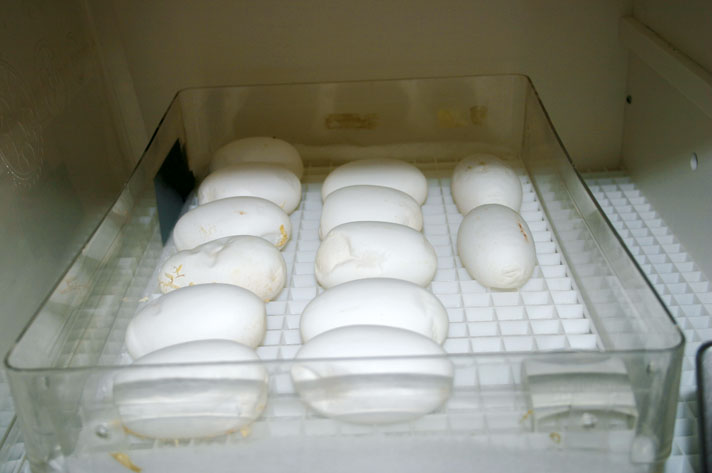
JESSICA JOHNSON
The author incubates black-headed python eggs in a plastic sweater box with holes drilled into the sides to provide ventilation. This box goes inside the incubator. Batting (the same material used for quilting) is used for an incubation substrate and a plastic grating cut to fit inside the egg box is placed over the batting. The eggs rest on top of the plastic grate.
A male black-headed python shows interest in a female by crawling along her back and tickling her with his spurs (small claw-like projections located near the male’s vent). If the female is receptive, copulation will soon take place.
I keep breeding black-headed python pairs together until ovulation has taken place. Although there is no reliable way to tell when this has occurred, a good rule of thumb is to remove the male when he no longer shows interest in the female. If successful ovulation has occurred, eggs will be laid around 60 days later.
Female black-headed pythons usually lay six to 20 eggs approximately 30 days after a post-ovulation shed. Do not remove the eggs for incubation until you’re sure she has finished laying all of them. When removing the eggs, don’t rotate them; keep the egg orientation the same. Placing a small X on top of each egg can help you to avoid rotating them during removal to the incubation.
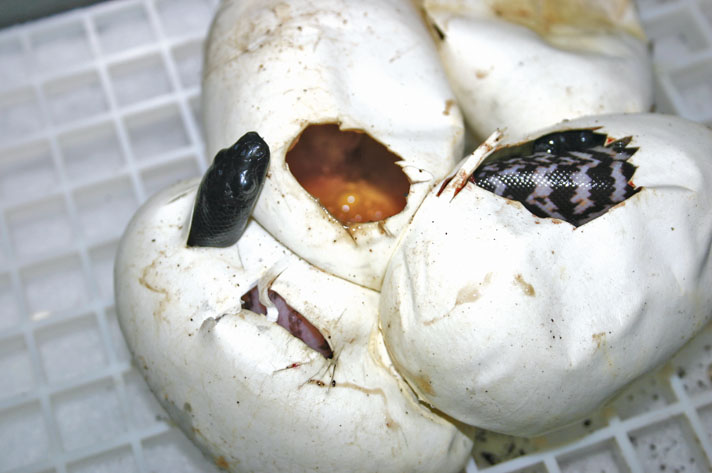
Jessica Johnson
Successful black-headed python egg incubation concludes when the baby pythons pip after 58 to 65 days. This is the moment all breeders anxiously await.
I incubate my black-headed python eggs in a plastic sweater box with holes drilled into the sides to provide some ventilation. This box goes inside the incubator. I use batting (the same material used for quilting) for an incubation substrate, placed on top of plastic grating cut to fit inside the egg box. The eggs are place on top of the batting so they do not touch the bottom of the egg box. Humidity is maintained inside the egg box at 70 to 80 percent. I use a Snake Shack incubator and incubate the eggs at 87 to 89 degrees. A small, shallow bowl of water is placed on the bottom of the incubator, and a small fan distributes the humidity evenly.
It is a good idea to set your incubator up before the eggs arrive. Set it up, run it and check the temperatures day and night. Depending on where you live, placing a blanket over the back of the incubator may help maintain constant temperatures. I use a Helix thermostat, because having a good thermostat is vital to successfully hatching black-headed python eggs.
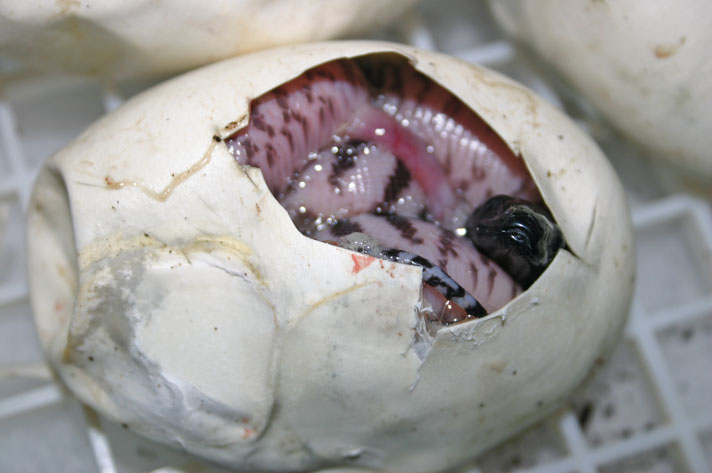
JESSICA JOHNSON
There is nothing better then seeing little black heads pop out of your eggs!
I always have a back-up incubator ready, too, just in case. You never know when something could happen. All the incubators I’ve used had glass doors or windows, making it easy to peek inside them without having to open them and let the hot air out. These also come in handy as the hatching date gets close, in case you have a baby that hatches out earlier than all the others. I can guarantee that will make your day if it happens!
I check daily for moisture on the inside of the egg box lid, which I wipe away so that it does not drip on the eggs. Although the eggs require humidity in order to hatch, if they come into direct contact with damp substrate they will get moldy and go bad within a few days. Preventing this is one of the most important and challenging things you will encounter when trying to breed black-headed pythons successfully.
Successful incubation concludes with black-headed python eggs pipping after 58 to 65 days. There is nothing better then seeing little black heads pop out of your eggs! Hatchlings can be kept much the same way as previously described for adults. I house my babies in drawers within a rack enclosure, with each drawer measuring 12 inches long by 6 inches wide by 3 inches tall. A water bowl and hide are also provided for each baby snake.
Like any animals you may keep, appropriate time and attention must be devoted to the beautiful black-headed python in order to maintain it successfully in captivity. This snake is one of the most impressive pythons around, and I feel honored to be able to keep and breed such an elegant animal.
Jessica Johnson brought her first snake-a red-tailed boa-home at age 17. For the past 15-plus years, she has kept a large variety of snakes and other reptiles, and has been breeding black-headed pythons and womas for more than 10 years. She also maintains a wide variety of dwarf reticulated pythons and carpet pythons. Learn more about her reticulated python breeding at thesnakepusher.com, and visit her on Facebook at facebook.com/jessicagorges.

